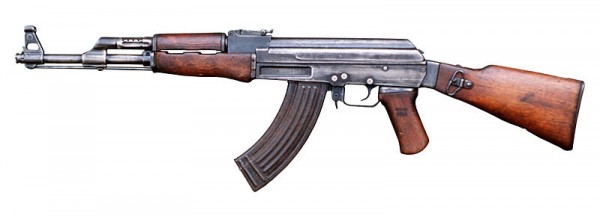What designers can learn from the AK-47
Mikhail Kalashnikov, the primary inventor of the AK-47, died yesterday in Russia. His invention is possibly the most popular weapon ever made, as the design has been reused and modified to make more than 100 million weapons (an estimate, as no one really knows how many there are).

I’m not a fan of guns, nor of the unavoidable ethical challenges in designing for killing. However there are still lessons any designer can learn from the AK-47’s unusual story of success.
- Simplicity can win. The AK-47 is not the best at any particular task rifles are asked to perform: there are rifles with better accuracy and lighter weight. However its simple, reliable, cheap to produce design has driven its popularity.
- Focus on the common frustrations. The iconic curved metal design of the the AK-47 magazine both reduced jams and improved reliability (its heavy case is harder to damage). It’s a strange aesthetic for a weapon to have one element facing the opposite direction and it makes a good example of Sullivan’s adage form follows function. Many similarly motivated design adjustments, often at the expense of total weight and even accuracy, reduced common frustrations found in other weapons, or reduced the need for training to use, repair and construct the weapon.
- Small markets can provoke designs that do well in large markets. The history of OXO Good Grips is they were trying to design kitchen tools for people with arthritis and other co-ordination issues. They discovered later their designs were valuable to everyone. The AK-47 was not designed with a plan for worldwide use. It was designed after WWII as a the basic service rifle for the Soviet Union. Because it was cheap to make and copy (in part because of failures to license the product successfully) the design was adopted by many other countries, and modified for dozens of different purposes. The Soviet Union used the AK-47 as its standard issue for arming allies, which helps explain the long history of the rifle’s success.
- Dominant design matters. For many poorly funded armies the AK-47 has become the dominant design. Even when better rifles are introduced the switching costs of learning how to use, repair and construct can seem prohibitive, as it requires losing some of the major advantages of the AK-47. Much like the QWERTY keyboard or English measurements, some designs once adopted are hard to replace even when better alternatives exist as the psychological and economic costs to switch outweigh the perceived improvement.
Related: Lessons From The Best Vehicle Of All Time

Nice teaching tool, Scott. I’m sure all us male computer nerds clicked here right away.
I chuckle at how Kalishnikov gave his “child” his name. In the novel (not the movie) version of Terminator 2 by Randal Frakes there is a scene where Sarah confronts Professor Dyson (an innocent name that can echo the ethically neutral science of astronomy) and rages at him that men always give their names to the guns they create. She thought that women were more peaceful because they gave birth.
Then I smiled to think down a long list of guns. Yup, men’s names.
Say, I guess we could add that design culture matters. During the war all sorts of German weapons, and tanks too, were designed with nice close tolerances. They kept mucking up in the field. If the Germans had anybody like Jobst, he couldn’t fight the culture (nor get them to simply copy better foreign stuff)
Popular = cheap.
Name one successful army due to using this rifle? There are zero. Numbers and climate had more to do with any army’s success while using this rifle than the rifle itself.
Having handled the weapon, I can tell you that it is prone to error and inferior in many ways. I can tell you why the clip is an inferior design.
What designers could learn from this would require gun knowledge, and would be negative in light of the many flaws.
All this adds up to is cheap, inaccurate and faulty equipment is more effective when given to many, many soldiers than better equipment given to a few.
Dominant design matters? No, not in this case. Millions of poor eat bad, cheap food. Does that design matter? It’s just cheap. It’s popular because it is cheap and more accessible. That’s not meaningful.
The Soviet Union was not a ‘small market.’ It was then the largest wartime market.
The ak47 was not simple, it was not stripped to its essentials. There was a balance between cost and functionality, but it was skewed grossly towards cost.
The curvature to the clip was simply to easily denote which way the clip fed into the gun when needing to reload in a second. Try doing that with a perfectly rectangular or even wedge shaped clip. It was heavier than its counterparts which is a flaw. ‘Strange to have it facing opposite direction?’ There is/was nothing strange about this.
The only lesson here is arming millions with an inferior gun is better than arming thousands with a superior gun.
You’ve clearly never used an AK if you think this foo.
“Name one successful army due to using this rifle? There are zero. Numbers and climate had more to do with any army’s success while using this rifle than the rifle itself”
How are you quantifying these statistics? Either armies have used the AK and won wars or they haven’t. To my knowledge they have.
Also, this is the most accurate weapon in Counter Strike, and that must mean something, right?!